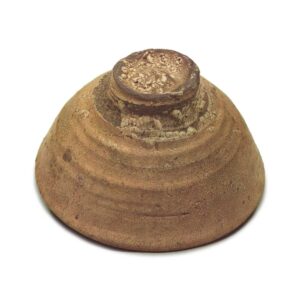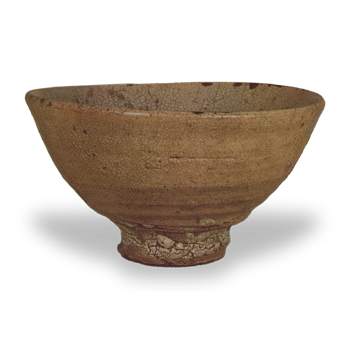




Famous Handmade Item, National Treasure
Accessories: Inner box, black lacquered with gold-leaf characters; middle box, lid with attached provenance document written by Araki Issai; outer box, paulownia wood with inscription
Provenance: Osaka Takeda Kizaemon → Honda Noto-no-kami → Sakai Nakamura Sōsetsu → Purchased by Lord Fuma during the An’ei era → After Lord Fuma’s death, his wife, Lady Seiraku-in, donated it to Kōhō-an Temple of Daitoku-ji
Recorded in
Collection of Famous Antiques Throughout the Ages, Fushimiya Memoirs, Collection of Famous Items, Yamazumi Family Edition, Korean Items Section, Collection of Famous Items from Various Families, Cloud State Lord’s Insect-Repelling Record, Honya Ryoun’s Record of Efforts, Fushimiya Soryu’s Memoirs, Illustrated Collection of Famous Tea Bowls, Matsudaira Fumai’s Memoirs, Toda Yashichi’s Collection of Letters, Taisho Era Guide to Famous Antiques
Dimensions
Height: 8.2–8.9 cm Mouth diameter: 15.2–15.4 cm Foot diameter: 5.3–5.5 cm Same height: 1.4 cm Weight: 370 g
Owner: Kyoto Gohō-an
The highest-ranked tea bowls used in tea ceremonies are well-shaped tea bowls, and among these, the most renowned is this Kisaemon well-shaped tea bowl. Therefore, it is no exaggeration to call it the king of tea bowls.
There are various theories about the origin of the name “well-shaped tea bowl.” However, recent research suggests that it was likely produced around the beginning of the Joseon Dynasty in the area near Jinju, northwest of Busan and near the port of Sacheon.
This well was once owned by a man named Kizaemon Takeda in Osaka during the Keicho era, hence its name. Later, he fell into poverty and became a beggar in Shimabara, but he never parted with this well, according to legend. It must have had a charm that drew people to it. It features a large, imposing bowl-shaped body with a bamboo-jointed high stand, and the persimmon-colored glaze forms granules along the sides of the stand and inside it, creating what is known as “kairagi.” It is a masterpiece well-equipped with all the hallmarks of a renowned well.
Inner box: Black lacquer with gold-leaf characters
Box and inscription: Middle box, lid underside: Transmission inscription by Araki Issai
Outer box: Paulownia wood with inscription



